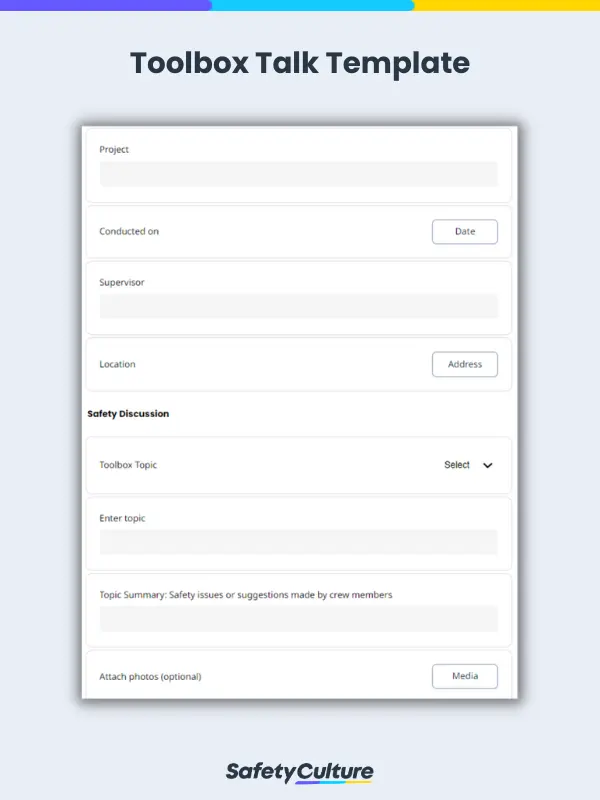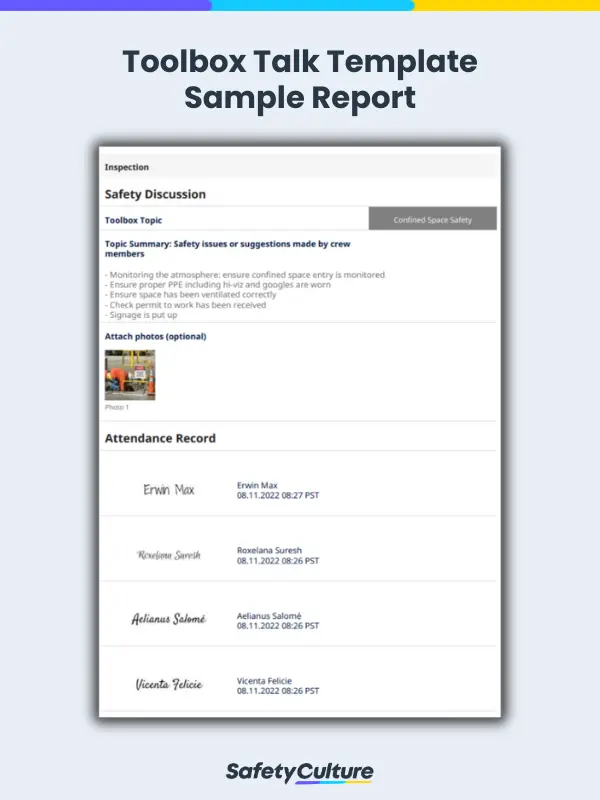What is a Toolbox Talk Template?
A toolbox talk template is a tool used by a team or group of workers during safety talks before commencing work. It can be used as a training guide and covers toolbox meeting topics. Conducting regular toolbox talks reduces workplace incidents and increases workers’ safety awareness.
Importance of Having a Toolbox Talk Template
Toolbox talks, also known as pre-start safety briefings, are quick and easily understandable safety discussions conducted before a certain shift starts at any job site. Although one session only takes about 5–10 minutes, it can cover a wide range of topics.
For this reason, a toolbox talk template, specifically one in a checklist form, can be helpful. A toolbox talk template can also serve as an official document you can refer to when identifying problems in the workplace and safety.
With a templated toolbox talk checklist, it becomes easier to create forms repeatedly, as everything is already in order. In particular, a toolbox talk template can help with the following tasks:
- Managing the toolbox talk topics to be discussed
- Collecting and understanding the responses of workers to specific questions
- Ensuring all safety protocols are remembered and hazards and risks prepared for
How Do I Write a Toolbox Talk Report?
Here is a simple guide to creating a toolbox talk report with a toolbox talk template:
- Conduct a toolbox talk discussion and indicate the topic.
- Provide a summary of the discussion by recording safety issues or suggestions made by crew members on your checklist template.
- Take photos of the meeting if necessary.
- Gather electronic signatures of the employees present for attendance purposes.
- Add remarks or overall recommendations.
- Sign off with a digital signature from the supervisor or manager.
What Do You Put in a Toolbox Talk Template?
Depending on the needs of those who will use the template, a toolbox talk template should include the following general format:
- List of topics that are relevant to the work to be done
- Summary of events from the supervisor’s perspective
- Suggestions from employees regarding the topics discussed
- Attendance record of employees present at the talk
- Signature of the supervisor who conducted the toolbox meeting
See this example of a filled out toolbox talk form:
For example, in a construction site, various health and safety hazards will be present. With a toolbox talk template in the format of your liking, you can include the most common causes of accidents and injuries and share preventive tips on how to avoid them.
FAQs about Toolbox Talk Templates
Toolbox talks can include topics focused specifically on safety issues or concerns relevant to the workplace. Examples could be about working at heights, hazardous substances, fire safety, ergonomics, or machine guarding. Basically, anything health and safety-related that you determine would be beneficial for the business and the employees to proactively address.
The toolbox talk report is usually done by the supervisor or the project manager because they are often the ones leading a toolbox talk. In some cases, a dedicated safety personnel will lead the discussion.
Toolbox talks can make a great difference when conducted before employees start to work on-site. These simple meetings are a vital safety measure for preventing bigger and more complex risks. Thus, managers and safety officers should invest their time and effort in using tools or apps to administer these safety meetings regularly.
Aside from ensuring proper safety orientation during pre-work, here are some benefits of performing toolbox talks:
- Boost worker knowledge of hazards and risks.
- Strengthen leaders’ and workers’ sense of responsibility.
- Improve team coordination and productivity.
- Establish a good communication system within teams.
- Document and organize safety meetings.
- Create a secure working space and safety culture.
A toolbox talk covers health and safety topics. Often, relevant safety issues identified before or during work are set as the topic. Depending on the needs of the workers and the scope of the work to be done, a toolbox talk may cover more than one topic.
But keep in mind that a toolbox talk isn’t a replacement for proper training. Instead, it serves as an orientation for workers to be mindful of their safety, so it should be short, efficient, and easy to comprehend.
Common topics discussed in a toolbox talk are some of the following:




